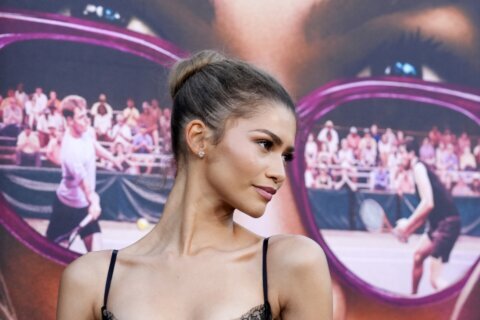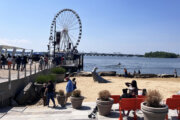The nation’s capital has rarely felt more creatively alive than it does right now on the National Mall.
Visitors are enjoying six interactive art installations across the National Mall now through Sept. 18.
“We’ve come together to elevate stories untold on the National Mall,” Trust for the National Mall President Catherine Townsend told WTOP. “This is an opportunity to bring an unprecedented and unique art exhibition to the National Mall for the first time. There have been a number of art installations around the mall through the years, but this is the first time we’ve curated six exhibits that tell the untold stories in pop-up memorials.”
It’s a project called “Beyond Granite: Pulling Together,” a partnership between the Trust for the National Mall, the National Capital Planning Commission and the National Park Service, curated by the nonprofit Monument Lab.
“It is important to us that our visitors see themselves reflected in the monuments and memorials on the National Mall — and these six installations really broaden that,” National Park Service spokesman Mike Litterst said. “We’ve got Dr. King of course, a lot of the Founding Fathers, but the six installations represent a diverse background.”
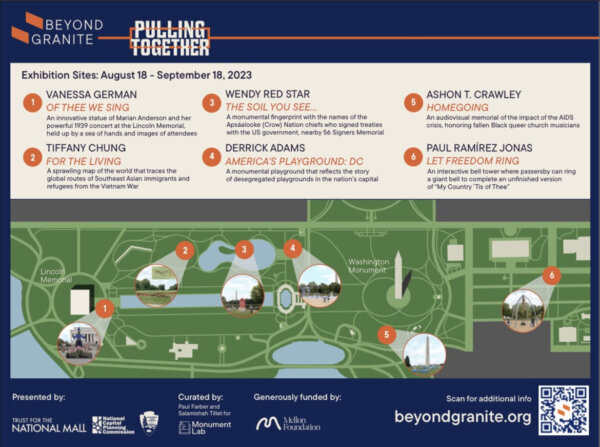
The first exhibition is vanessa german‘s “Of Thee We Sing” located on the steps of the Lincoln Memorial.
“That is an interactive statue of Marian Anderson and represents her powerful 1939 concert at the Lincoln Memorial, held up by a sea of hands and historic images of the attendees,” Townsend said. “That was a very big moment for the National Mall and began the Mall as a civic stage. Marian Anderson singing there really inspired Martin Luther King’s ‘I Have a Dream’ speech at the March on Washington, now celebrating its 60th anniversary.”
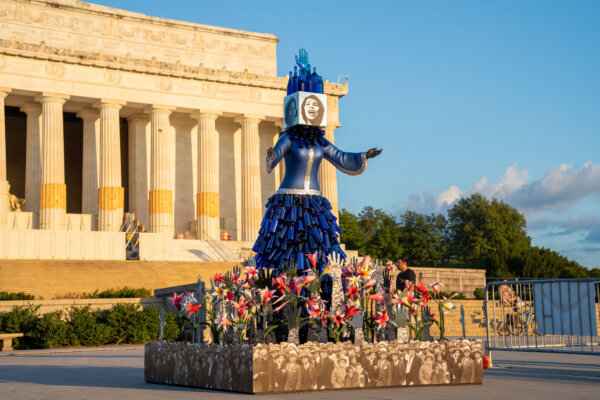
Arlington resident Joan Oppel came to see the exhibits after hearing about them in the news.
“I came specifically,” Oppel told WTOP. “I think the Marian Anderson [exhibit] was terrific at the Lincoln Memorial … It’s a wonderful representation, and it’s not too big, so it’s not overwhelming, it’s just very impressive. The Lincoln Memorial is iconic, I’ve been to many things there, so to see her there as well is excellent. … It does tie it together.”
The second exhibition is Tiffany Chung’s “For the Living” located at 22nd Street and Constitution Avenue.
“It’s a map of the world that traces the global routes of Southeast Asian immigrants and refugees from the Vietnam War,” Townsend said. “That art exhibit sits adjacent to the Vietnam Veterans Memorial.”
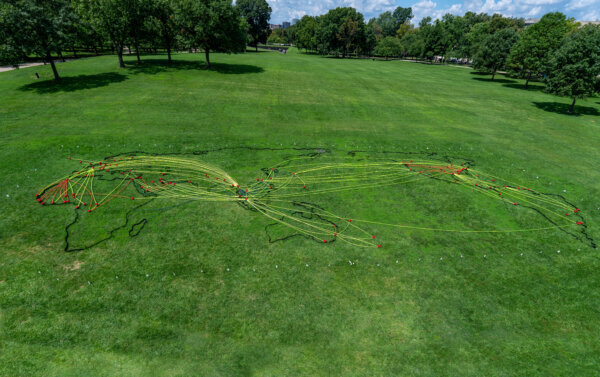
The third exhibit is Wendy Red Star’s “The Soil You See” located at 19th Street and Constitution Avenue.
“It’s a monumental fingerprint with the names of the Crow Nation chiefs who signed treaties with the U.S. government,” Townsend said. “It sits right on Signers Island at Constitution Gardens. It’s out in the middle of the lake, you walk over a bridge and you get to witness this beautiful fingerprint, which is actually Wendy Red Star’s thumbprint, but it’s meant to be juxtaposed against the 56 Signers, people who signed those treaties in the 1800s.”
She’s referring to names like “John Hancock” on the Declaration of Independence Memorial.
“You think about it, some of those signers were somewhat instrumental in how the Native Americans lost their land, even though that was somewhat later, but still, it was the impetus,” Oppel said. “The fingerprint also includes quotes at the top, which are very moving, quotes from Native American leaders [juxtaposed with] all the white men who were signing and talking about ‘liberty and justice for all,’ but it only meant for white men at the time.”
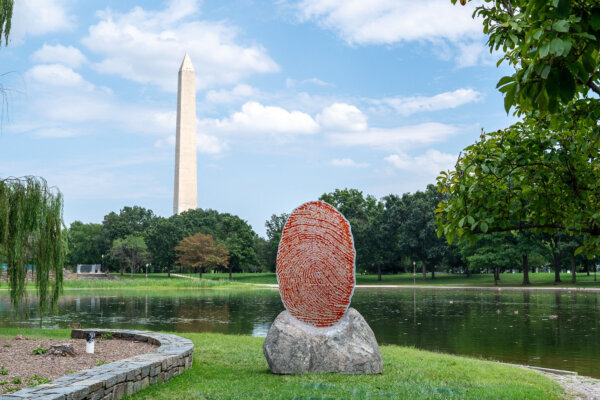
The fourth exhibition is Derrick Adams’ “America’s Playground” located at 17th Street and Constitution Avenue.
“This playground is pretty special,” Townsend said. “We call it a monumental playground that reflects the story of desegregated playgrounds in the nation’s capital. Part of it is colorful and the other part is black, gray and white. It’s supposed to showcase the change that happened where we’re uniting children to play on the same playground. … The photographs are of children who played during desegregation at Edgewater Park in Washington D.C.”
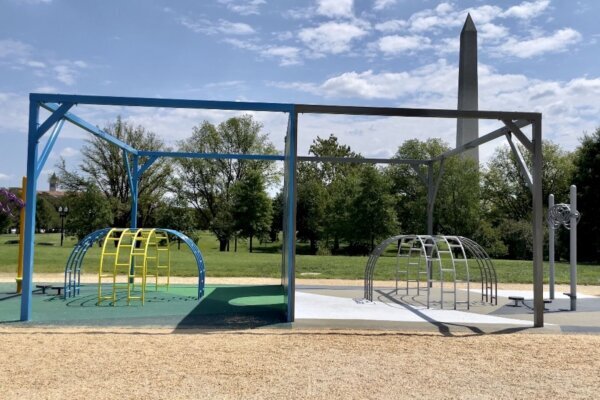
A Florida resident, Renold Oseme, was surprised to see an artistic playground during his tourist trek.
“I like it, I recommend people to visit this place,” Oseme told WTOP. “I just came from the Washington Monument and the Lincoln Memorial. … For me it is important because back in the day it was very difficult to see people of color, between segregation, apartheid, that was very difficult, but right now, I think it’s a good thing to have a unification of people from different [races]. … We have to keep going to work at that to put people together.”
A Polish mother brought her three kids to the playground after an international visit the White House. The kids had fun playing outdoor instruments at the edge of the playground — and so did the young-at-heart adults.
“I love the playground because I got to play on the xylophones with the kids,” Oppel said.
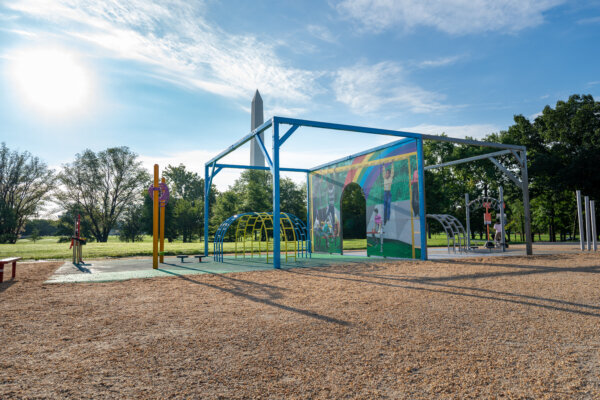
The fifth exhibition is Ashon T. Crawley’s “HOMEGOING” located on the south side of the Washington Monument.
“That is an audiovisual memorial about the impact of the AIDS crisis that centers spirituality as a means of honoring fallen Black queer church musicians,” Townsend said. “It’s this beautiful exhibit that you listen to music and voices and readings of names as you go through this wonderful maze that represents a number of spiritual feelings of remembrance and acceptance. It’s really lovely. You can hear the entire track in about 45 minutes.”
Under the orange “Pulling Together” tents, young volunteers were happy to share trivia.
“Ashon T. Crawley was a choir director, he grew up in a Black Pentecostal tradition,” Alexandria resident Dylan Krinberg told WTOP. “The piece is about remembrance, grieving and a celebration of life for queer Black gospel singers who passed away during the AIDS epidemic. … You’re allowed to sit on the piece, you can stand on it. … The second part might appear as a maze is actually Arabic script … meaning ‘let this prayer be heard.'”
“What art have we lost because of the inability to accept these men for who they were?” George Washington University graduate Logan Fillizola told WTOP. “In general, the treatment of the AIDS crisis is something that was pushed to the back burner and not as important. How many men lost their lives for seemingly no reason?”
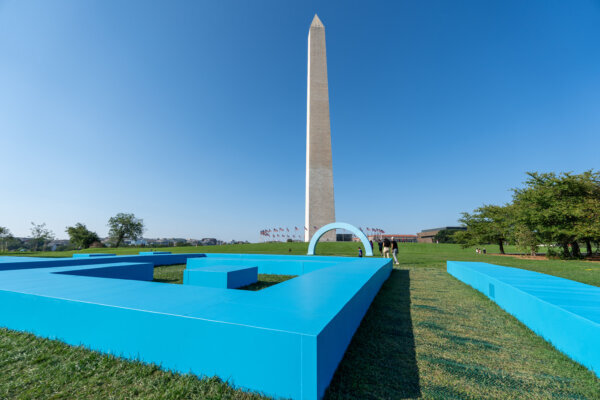
Finally, the sixth exhibit is Paul Ramirez Jonas’ “Let Freedom Ring” located at 12th Street and Madison Drive right across from the Smithsonian National Museum of American History and National Museum of Natural History.
“This is an interactive bell tower where passersby can ring a giant bell to complete the unfinished version of ‘My Country, ‘Tis of Thee’ and declare their own visions for freedom,” Townsend said. “It’s pretty powerful. It’s a series of bells [overhead], we start it by the bell on the ground, then it plays the entire song but it leaves out the last chime. It invites visitors to interact with it, pull a lever and ring the final bell. Visitors get to do the grand finale.”
One staffer, Adam Schulman, was a former student of the artist at Cornell University.
“I was very lucky to be his student,” Schulman told WTOP. “The 32 bells play the tune of ‘My Country, ‘Tis of Thee.’ The project is an invitation for participants to complete the lyrics. By inviting participants to complete the melody, Paul allows them to make it their own. It depends on their participation just as it depends on their participation in the democratic ideal. … There are two inscriptions on the bell: ‘I want to be free from‘ and ‘I want to be free to.'”

If you look closely, the name of the bell is also significant.
“The bell is the Freedom Bell, not the Liberty Bell — you need to think about the difference,” Oppel said.
The grand finale came as Virginia resident Beatrice Birihanyuma rang the bell and screamed victoriously.
“That was powerful for me,” Birihanyuma told WTOP. “I feel like I’m one of Beethoven’s students!”



